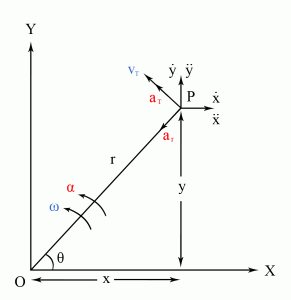Physics › Kinematics ›
Angular Velocity and Acceleration
Angular velocity and acceleration, including centripetal and coriolis acceleration.
Overview
Key facts
Angular velocity is the rate of change of the position-specific angle  with respect to time:
with respect to time:
 Angular acceleration is the rate of change of angular velocity with respect to time:
Angular acceleration is the rate of change of angular velocity with respect to time:
 The centripetal acceleration can be defined as:
The centripetal acceleration can be defined as:
 The Coriolis component of acceleration, or compound supplementary acceleration can be defined as:
The Coriolis component of acceleration, or compound supplementary acceleration can be defined as:

Angular velocity and acceleration are vector quantities that describe an object in circular motion. When an object, like a ball attached to a length of string, is rotated at a constant angular velocity, it is said to be in uniform circular motion. However, if the object is rotated at increasing or decreasing speeds, it can be said to be in a state of angular acceleration. The acceleration can have a centripetal component (acting inwards toward the axis of rotation) or a Coriolis component(acting perpendicular to the direction of velocity and the axis of rotation).
Angular Velocity
In order to define angular velocity, consider a particle
Angular Acceleration
In order to define the acceleration, we first have to calculateExample:
[imperial]
Example - Linear velocity
Problem
Consider that the hard disk of a computer is circular and rotates with an angular velocity of 7200 revolutions per minute.
Calculate the linear velocity (in miles per hour) of a particle which is found 2 inches away from the center of the hard disk.
Workings
The angular velocity of the hard disk expressed in SI units is:
 As the linear velocity can be defined as
As the linear velocity can be defined as  , we obtain the linear velocity of the particle as:
, we obtain the linear velocity of the particle as:

or, by converting it in miles per hour:
Solution
Reference
- For an application of angular velocity to mechanics, also see the reference page on Velocity and Acceleration of a Piston .
 Login
Login

